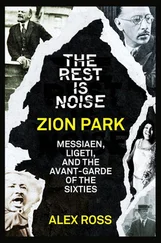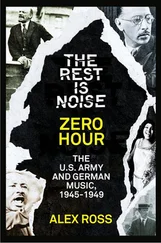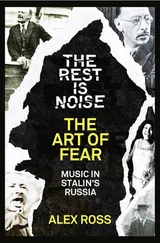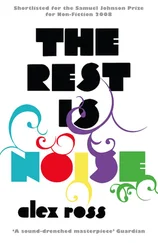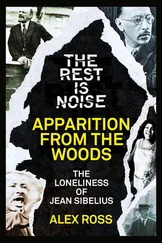—Thomas Mann, Doctor Faustus
|
HAMLET: |
… —the rest is silence. |
|
HORATIO: |
Now cracks a noble heart. Good night, sweet prince,And flights of angels sing thee to thy rest! [March within.]Why does the drum come hither? |
Title Page
Copyright
Note to Readers
Praise
Dedication
Epigraph
Preface
Where to Listen
Part I - 1900–1933
1. The Golden Age
2. Doctor Faust
3. Dance of the Earth
4. Invisible Men
5. Apparition from the Woods
6. City of Nets
Part II - 1933–1945
7. The Art of Fear
8. Music for All
9. Death Fugue
Part III - 1945–2000
10. Zero Hour
11. Brave New World
12. “Grimes! Grimes!”
13. Zion Park
14. Beethoven Was Wrong
15. Sunken Cathedrals
Epilogue
Keep Reading
Suggested Listening and Reading
Notes
Index
Acknowledgments
About the Author
About the Publisher
In the spring of 1928, George Gershwin, the creator of Rhapsody in Blue, toured Europe and met the leading composers of the day. In Vienna, he called at the home of Alban Berg, whose blood-soaked, dissonant, sublimely dark opera Wozzeck had had its premiere in Berlin three years earlier. To welcome his American visitor, Berg arranged for a string quartet to perform his Lyric Suite, in which Viennese lyricism was refined into something like a dangerous narcotic.
Gershwin then went to the piano to play some of his songs. He hesitated. Berg’s work had left him awestruck. Were his own pieces worthy of these murky, opulent surroundings? Berg looked at him sternly and said, “Mr. Gershwin, music is music.”
If only it were that simple. Ultimately, all music acts on its audience through the same physics of sound, shaking the air and arousing curious sensations. In the twentieth century, however, musical life disintegrated into a teeming mass of cultures and subcultures, each with its own canon and jargon. Some genres have attained more popularity than others; none has true mass appeal. What delights one group gives headaches to another. Hip-hop tracks thrill teenagers and horrify their parents. Popular standards that break the hearts of an older generation become insipid kitsch in the ears of their grandchildren. Berg’s Wozzeck is, for some, one of the most gripping operas ever written; Gershwin thought so, and emulated it in Porgy and Bess, not least in the hazy chords that float through “Summertime.” For others, Wozzeck is a welter of ugliness. The arguments easily grow heated; we can be intolerant in reaction to others’ tastes, even violent. Then again, beauty may catch us in unexpected places. “Wherever we are,” John Cage wrote in his book Silence, “what we hear is mostly noise. When we ignore it, it disturbs us. When we listen to it, we find it fascinating.”
Twentieth-century classical composition, the subject of this book, sounds like noise to many. It is a largely untamed art, an unassimilated underground. While the splattered abstractions of Jackson Pollock sell on the art market for a hundred million dollars or more, and while experimental works by Matthew Barney or David Lynch are analyzed in college dorms across the land, the equivalent in music still sends ripples of unease through concert audiences and makes little perceptible impact on the outside world. Classical music is stereotyped as an art of the dead, a repertory that begins with Bach and terminates with Mahler and Puccini. People are sometimes surprised to learn that composers are still writing at all.
Yet these sounds are hardly alien. Atonal chords crop up in jazz; avant-garde sounds appear in Hollywood film scores; minimalism has marked rock, pop, and dance music from the Velvet Underground onward. Sometimes the music resembles noise because it is noise, or near to it, by design. Sometimes, as with Berg’s Wozzeck, it mixes the familiar and the strange, consonance and dissonance. Sometimes it is so singularly beautiful that people gasp in wonder when they hear it. Olivier Messiaen’s Quartet for the End of Time, with its grandly singing lines and gently ringing chords, stops time with each performance.
Because composers have infiltrated every aspect of modern existence, their work can be depicted only on the largest possible canvas. The Rest Is Noise chronicles not only the artists themselves but also the politicians, dictators, millionaire patrons, and CEOs who tried to control what music was written; the intellectuals who attempted to adjudicate style; the writers, painters, dancers, and filmmakers who provided companionship on lonely roads of exploration; the audiences who variously reveled in, reviled, or ignored what composers were doing; the technologies that changed how music was made and heard; and the revolutions, hot and cold wars, waves of emigration, and deeper social transformations that reshaped the landscape in which composers worked.
What the march of history really has to do with music itself is the subject of sharp debate. In the classical field it has long been fashionable to fence music off from society, to declare it a self-sufficient language. In the hyper-political twentieth century, that barrier crumbles time and again: Béla Bartók writes string quartets inspired by field recordings of Transylvanian folk songs, Shostakovich works on his Leningrad Symphony while German guns are firing on the city, John Adams creates an opera starring Richard Nixon and Mao Zedong. Nevertheless, articulating the connection between music and the outer world remains devilishly difficult. Musical meaning is vague, mutable, and, in the end, deeply personal. Still, even if history can never tell us exactly what music means, music can tell us something about history. My subtitle is meant literally; this is the twentieth century heard through its music.
Histories of music since 1900 often take the form of a teleological tale, a goal-obsessed narrative full of great leaps forward and heroic battles with the philistine bourgeoisie. When the concept of progress assumes exaggerated importance, many works are struck from the historical record on the grounds that they have nothing new to say. These pieces often happen to be those that have found a broader public—the symphonies of Sibelius and Shostakovich, Copland’s Appalachian Spring, Carl Orff’s Carmina burana. Two distinct repertories have formed, one intellectual and one popular. Here they are merged: no language is considered intrinsically more modern than any other.
In the same way, the story criss-crosses the often ill-defined or imaginary border separating classical music from neighboring genres. Duke Ellington, Miles Davis, the Beatles, and the Velvet Underground have substantial walk-on roles, as the conversation between Gershwin and Berg goes on from generation to generation. Berg was right: music unfolds along an unbroken continuum, however dissimilar the sounds on the surface. Music is always migrating from its point of origin to its destiny in someone’s fleeting moment of experience—last night’s concert, tomorrow’s solitary jog.
The Rest Is Noise is written not just for those well versed in classical music but also—especially—for those who feel passing curiosity about this obscure pandemonium on the outskirts of culture. I approach the subject from multiple angles: biography, musical description, cultural and social history, evocations of place, raw politics, firsthand accounts by the participants themselves. Each chapter cuts a wide swath through a given period, but there is no attempt to be comprehensive: certain careers stand in for entire scenes, certain key pieces stand in for entire careers, and much great music is left on the cutting-room floor.
Читать дальше

